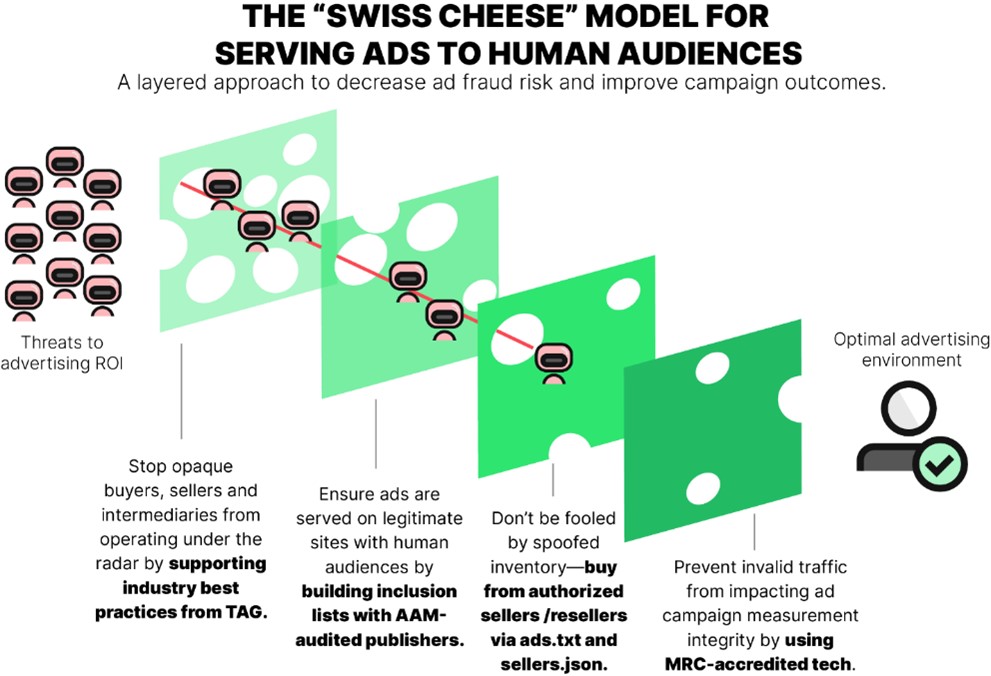One benefit to moving media buying in house is greater control over your media spend. But the digital-media supply chain can be complex, confusing and opaque. Consequently, marketers risk wasting a portion of their spend on ads that get served to bots instead of humans.
It’s important to understand how advertising dollars move from the marketer through the media supply chain and eventually to the publisher. It’s even more important to know the risks of ad fraud along that path. Ad fraud occurs when publishers and other vendors knowingly or unknowingly skew performance metrics like clicks and impressions to overcharge media buyers.
The good news is there are many resources available to minimize that risk, and different industry solutions that work together to help marketers plan and buy media more effectively.
Risk: Incorrect measurement
Safeguard: MRC-accredited measurement vendors
For buyers and sellers to transact fairly, they need integrity in ad campaign measurement. Performance metrics are often inflated by bots—automated software programs that mimic human activity online.
Advertisers and agencies use ad fraud detection vendors to measure fraud in their campaigns. These services help protect buyers from paying for non-human traffic. They typically use a process called in-ad measurement: attaching digital ads to web code that accurately counts each ad exposure as a person or a bot.
The Media Rating Council (MRC) sets industry standards and guidelines to define and measure invalid traffic (IVT). Marketers and agencies can use MRC-accredited vendors to detect and measure IVT from an ad delivery perspective and have confidence that their processes and procedures adhere to industry standards for measurement services.
Risk: Supply chain opacity allows fraudsters to operate under the radar
Safeguard: Supply chain transparency and control
It’s important for marketers to have visibility into how their digital ads move through the supply chain from buyers to sellers.
The IAB Tech Lab develops standards and solutions to increase supply-chain transparency and control. Tools such as Ads.txt, Sellers.json and the OpenRTB protocol allow sellers to clearly communicate the details of their transactions. These tools also give marketers insight into these details and better control of their transactions by identifying authorized sellers and resellers of ad inventory and all participants involved. This transparency helps address domain spoofing, which occurs when fraudsters use fake website domains to misrepresent their identities in an attempt to earn ad dollars.
Additionally, a shared set of standards helps marketers interact with companies across the supply chain. The Trustworthy Accountability Group brings companies together to set standards that promote greater transparency. TAG’s Certified Against Fraud program certifies companies—buyers, direct sellers and intermediaries—that meet the group’s guidelines and best practices for combating invalid traffic.
Risk: Low-quality sites with bot traffic
Safeguard: Audited publishers
Marketers need foundational assurance that their ads are not running on questionable sites or being served to bots that go undetected by measurement technologies. The AAM Digital Publisher Audit provides greater transparency at the publisher level. Auditors assess a publisher’s business operations and traffic sourcing policies and analyze the quantity and quality of their website traffic.
Marketers can use the audit as a benchmark to make more informed media buying decisions through the AAM Audited Domain List. This solution is free to marketers, though if they don’t see particular publishers on the list, they should encourage those media partners to participate in the audit.
What this means for in-house media teams
Each of these solutions attempts to mitigate a specific high-risk area: measurement integrity, supply-chain transparency and control, best practices and publisher audience validation. Think of them as connected, coordinated, layered safeguards that help increase campaign performance.
The Association of National Advertisers supports these efforts to make the solutions work together. By implementing every layer, individual advertisers and agencies have the best chance to optimize their results.

Alliance for Audited Media is an IHAF supplier member and not-for-profit organization for media auditing. Visit their website to learn more.

